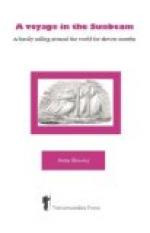[Illustration: Maitea.]
At 5 a.m. we made the island of Maitea, and expected to reach it in about an hour and a half; but the wind fell light, and it was a quarter to ten before we got into the gig and set out for the shore. There are not many instructions about landing, either in Captain Cook or Findlay, but the latter mentions that houses are to be found on the south side of the island. We thought, however, we could distinguish from the yacht a little cove, close to some huts, at another part of the shore, where the surf did not break so heavily. We accordingly rowed straight for it, and as we approached we could see the natives coming down from all parts to meet us, the women dressed in the same sort of long, bright, flowing garments we had seen at Hao Harpe, with the addition of garlands round their necks and heads, the men wearing gay-coloured loin-cloths, shirts of Manchester cotton stuff, flying loose in the wind, and sailors’ hats with garlands round them, or coloured silk handkerchiefs—red and orange evidently having the preference—tied over their heads and jauntily knotted on one side. Several of the men waded out into the surf to meet us, sometimes standing on a rock two feet above the water, sometimes buried up to their necks by a sudden wave. But the rocks were sharp, the only available passage was narrow, and the rollers long and high; and altogether it looked, upon a closer inspection, too unpromising a place to attempt a landing. Much to the disappointment of the natives, therefore, we decided to go round and try the other side of the island. Seeing us prepare to depart, the people on shore immediately launched a tiny canoe, with an enormous outrigger, and a man dressed in a pale green shirt, dark blue and yellow under garment, and with a silk handkerchief and garland on his head, came alongside and made signs that he would take us ashore one by one in his frail-looking craft. But the heavy Pacific rollers and the sharp rocks daunted us, and we declined his offer with thanks, and rowed off to the southward. Anything more enticing than the cove we were quitting can hardly be imagined. A fringe of cocoa-nuts and bread-fruit trees, overhanging an undergrowth of bright glossy foliage and flowers, a few half-hidden palm-leaf covered huts, from one of which—I suppose the chief’s—a tattered Tahitian flag floated in the breeze, a small schooner drawn up among the trees and carefully covered with mats, the steep sugar-loaf point, at the entrance to the cove, clothed to its summit with grass and vegetation: these were the objects which attracted our attention in our hurried survey of the scene.
[Illustration: Our Boatman]




